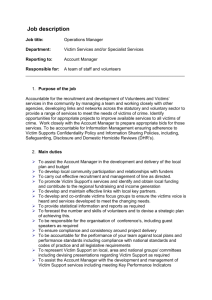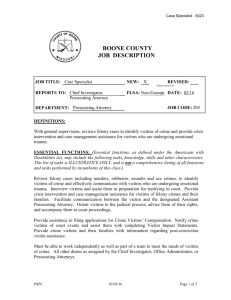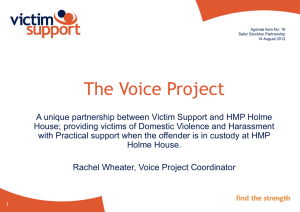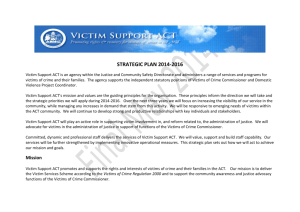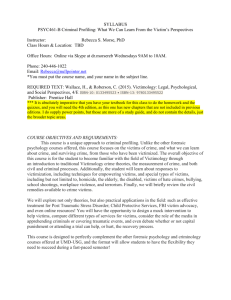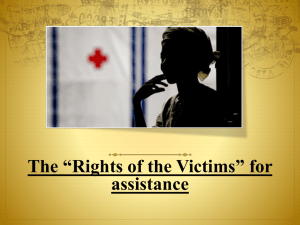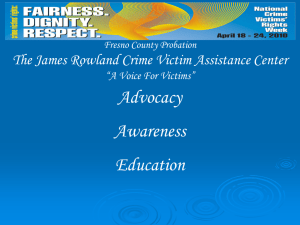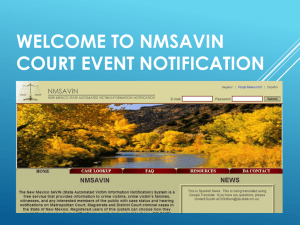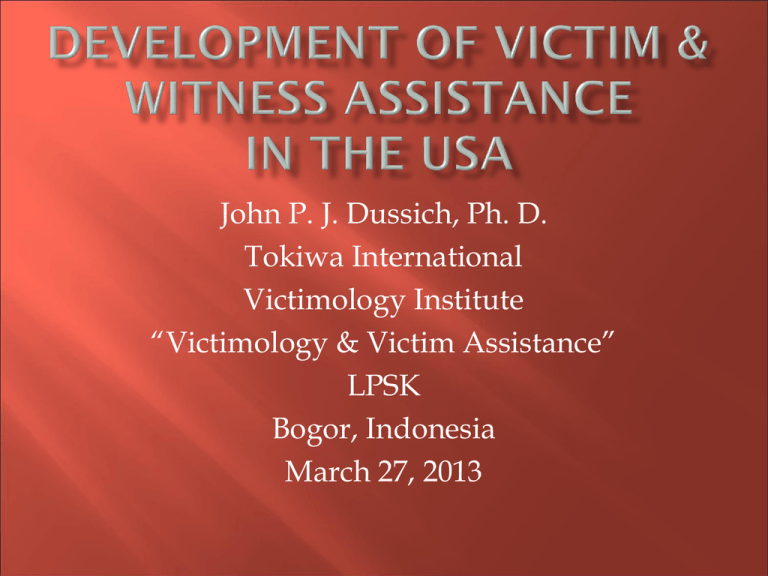
John P. J. Dussich, Ph. D.
Tokiwa International
Victimology Institute
“Victimology & Victim Assistance”
LPSK
Bogor, Indonesia
March 27, 2013
The first victim assistance programs in the USA
were established in 1972 in the private NGO sector.
By 1998 there were about 20,000 private & public
programs that provided support and assistance to
crime victims
Today there are about 30,000 private & public
programs which have become a part of the US’s
criminal and juvenile justice infrastructure.
Victim assistance agencies in the American private, nonprofit sector have also grown since the early 1970s. Today
there are about:
2,500 programs for battered women
2,600 rape crisis centers nationwide
230 chapters of Parents of Murdered Children
520 chapters of Mothers against Drunk Driving
360 jurisdictions that have multidisciplinary children’s
advocacy centers
530 communities that have Triad programs that assist
elder victims
“The US movement” started just over 3 decades ago with
the support of national NGOs.
Founded in 1976 in Fresno
World’s oldest broad-based victim
services and rights group
Membership organization guided
by 4 purposes:
(1) service to its members,
(2) system advocacy for victims,
(3) training and education resource,
(4) direct service to victims
Founded in 1977
Represents state compensation programs
Provides advocacy, training, and technical
assistance, and fosters communication among
state programs
Represents all matters affecting state
compensation programs
Founded in 1978 by Charlotte and
Bob Hullinger after the murder of
their daughter, Lisa
Goal is to allow the grief of family
members to be shared with others
with similar experiences
Founded in 1979 by the late Frank Carrington,
national victims’ rights activist
Dedicated to promoting victims’ rights in the
civil and criminal justice systems
Administers the National Victim Assistance
Academy (NVAA)
Founded in 1980 by Cindy
Lightner after her daughter,
Cari, was killed by a repeat
drunk driving offender in
Fair Oaks, CA
MADD’s mission is to stop
drunk driving and support
victims of this crime
Established in 1984 with the passage by Congress of
the Missing Children’s Assistance Act
John and Reve Walsh (son Adam)
NCMEC serves as a clearinghouse and national
resource center for helping exploited children
Established in 1984 through the Victims of
Crime Act (VOCA)
OVC administers the Crime Victims Fund –
derived from fines/penalties paid by
offenders (not tax dollars)
Fund state victim assistance and
compensation programs, support services,
training, education, and technical
assistance to CJS professionals, victim
assistance programs in Indian country,
and initiate projects with national impact.
$1.6 billion to support domestic violence
and sexual assault programs and
research
At the local level, communities are
increasingly supporting victim service
programs through voter tax millages,
budget line items, local levies (taxes),
and even community budgeted victim
assistance centers (ex: Jacksonville, FL)
Sponsorship by, and affiliation with, a host agency has a strong
influence on the services a program provides to victims
regardless of their needs:
Police based – want cooperation with the investigations and
enhanced public relations.
Prosecutor based – want cooperation during the trial as
witnesses.
The advantage to
police-based
programs is their
connection with
police, who have
mobility and 24 hour
availability
The advantage to
prosecutor-based
programs is their
speedy access to case
information, court
dates, and court escort
services.
Nonprofit criminal justice
or social service agencies
provide access to all
victims, including those
who do not trust the
criminal justice system.
They often provide
hotline, emergency
financial aid and social
services with extensive
use of volunteers.
Police-based: Victim Assistance Unit and Family Crisis
Intervention Team of Rochester, NY
Urban Prosecutor-based: Victim/Witness Services of
Milwaukee County, WI
Rural Prosecutor-based: Victim/Witness Division of
Greene County Prosecutor’s Office, Xenia, OH
Nonprofit: Crime Victim Centers of Minneapolis and
St. Paul, MN
Began in 1975 with an LEAA grant
Services are located in the police department’s Central
Investigation Division (CID)
Provides assistance in filing for compensation, victim
outreach, case status, court process, restitution, property,
transportation, home/hospital visits, accompaniment to
court, agency referrals, counseling, and education
programs
FACIT –
Provides “crisis intervention, short-term counseling, follow-up
support services for child victims, domestic trouble, and
juvenile delinquency”
Liaison with Child Protective Services
Utilizes community human service agencies and law
enforcement personnel
FACIT counseling specialists
Staffed from 8am to 10pm with 1 program coordinator and 8
counseling specialists
FACIT is involved in cases of child
abuse in neglect in two ways:
A child abuse specialist being
requested a the scene of the crime, to
meet the victim at the hospital, or to
assist at the police interview
Paperwork is forwarded to the CARE
Unit where it is logged in and
assigned a child abuse specialist
Most child abuse and neglect cases
remain open and active for 2-3 months,
and are closed with no prosecution.
Victim/Witness Services Unit is located in
the District Attorney’s Office
Victim/Witness Services – Children’s Court
Center
Court Watch
Sexual Assault Counseling Unit
Witness Protection Unit
Created in 1982
Provides services to all victims of crime from the
time the crime is reported through the entire
investigation and prosecution process.
›
›
›
Began in 1977
Is operated by the Minnesota Citizens Council on Crime
and Justice, a nonprofit organization formed in 1959 to
provide a vehicle for citizen involvement in the criminal
justice system
The CVC provides a place where victims of violent and
property crime may call or come for help beyond what
the police provide - elderly & handicapped services,
information and referral resources, and court-related
services.
Supported by these national
NGO professionals there are
3 primary hosts for all victims
with assistance programs are :
law enforcement departments,
prosecutor’s offices, and
not-for-profit criminal justice/
social service agencies.


